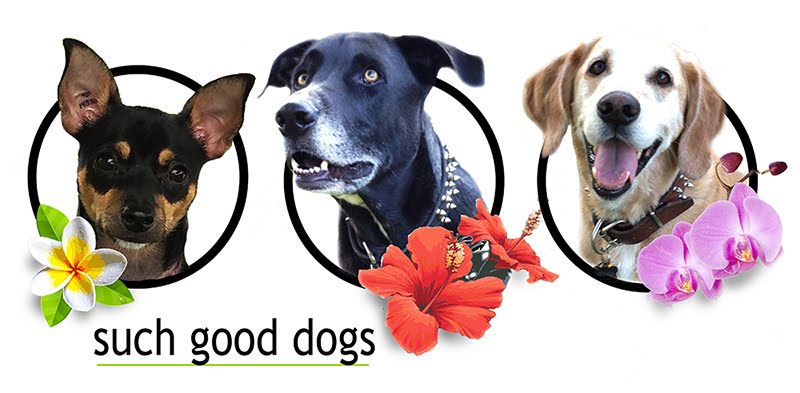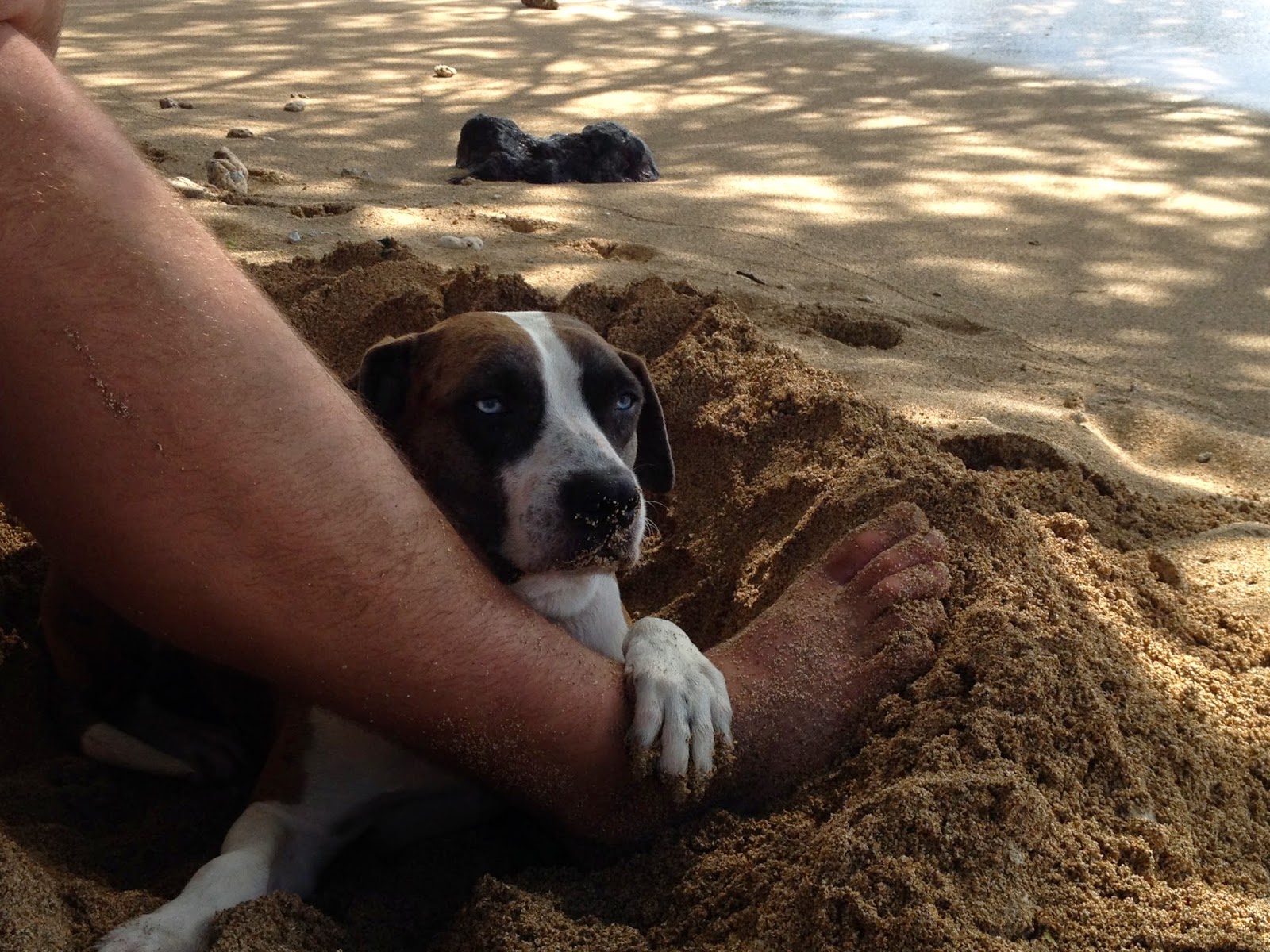(First see Animal Behavior College Mentor Training--Part One)
PART TWO:
Class may be over, but my Mentee also accompanied me on several private training appointments. During these appointments Jess was required to watch, participate, and eventually help teach.
 For this private lesson, Jess was asked to go over the Leave-It command with Melissa and her dog Lucky. Melissa has been training with Such Good Dogs with her two dogs Lucky and Hazel. In this lesson we focused on just Lucky. Since Hazel has come into the picture (about a year ago), some of Lucky's bad behaviors have gotten worse. One thing we have been working on is Lucky's aggression towards men. With the addition of the new dog came a power struggle in the house. Although Melissa is doing amazingly better about being a good pack leader, there are still things to work on. One helpful command to practice is the Leave-It. When properly taught, this command can be used to tell your dog to leave anything alone, from people to other dogs, or even small animals and random trash. Properly teaching a good Leave-It command can help keep yourself, your pet, and everyone else safe.
For this private lesson, Jess was asked to go over the Leave-It command with Melissa and her dog Lucky. Melissa has been training with Such Good Dogs with her two dogs Lucky and Hazel. In this lesson we focused on just Lucky. Since Hazel has come into the picture (about a year ago), some of Lucky's bad behaviors have gotten worse. One thing we have been working on is Lucky's aggression towards men. With the addition of the new dog came a power struggle in the house. Although Melissa is doing amazingly better about being a good pack leader, there are still things to work on. One helpful command to practice is the Leave-It. When properly taught, this command can be used to tell your dog to leave anything alone, from people to other dogs, or even small animals and random trash. Properly teaching a good Leave-It command can help keep yourself, your pet, and everyone else safe.  Finally Jess is asked to observe the client perform the Leave-It command she just demonstrated. While watching the client, it is important for Jess to notice what she does right, but also where she could use improvement. Jess was correct to remind the client to only repeat the command one time. This is important for any cue or command you are teaching. Say it ONE TIME, and ONE TIME ONLY. Repeating a command only teaches a dog that maybe the 5th or 10th time I say it means do it. Say your command one time only. If the dog does not comply, wait 30 seconds, then give your "Uh-oh" (No Reward Marker), move positions (this helps re-set the training in the dog's mind), then try again.
Finally Jess is asked to observe the client perform the Leave-It command she just demonstrated. While watching the client, it is important for Jess to notice what she does right, but also where she could use improvement. Jess was correct to remind the client to only repeat the command one time. This is important for any cue or command you are teaching. Say it ONE TIME, and ONE TIME ONLY. Repeating a command only teaches a dog that maybe the 5th or 10th time I say it means do it. Say your command one time only. If the dog does not comply, wait 30 seconds, then give your "Uh-oh" (No Reward Marker), move positions (this helps re-set the training in the dog's mind), then try again. In this picture, Jess works with Hazel (Melissa's other dog). Hazel is young and very high-energy. One of the issues Melissa has with Hazel is her need to want to chase after things when out on a walk. She enjoys picking up anything from leaves and branches, to random trash and dead animals. We will again use the Leave-it command to practice getting Hazel to leave things as they pass. Jess assists by walking by Melissa and Hazel and dropping random plant objects.
In this picture, Jess works with Hazel (Melissa's other dog). Hazel is young and very high-energy. One of the issues Melissa has with Hazel is her need to want to chase after things when out on a walk. She enjoys picking up anything from leaves and branches, to random trash and dead animals. We will again use the Leave-it command to practice getting Hazel to leave things as they pass. Jess assists by walking by Melissa and Hazel and dropping random plant objects. Finally, Jess is asked to teach several basic manners commands. In this first picture, Jess demonstrates to a client how to do a proper Look. Here you can see the dog looking directly at Jess. This is exactly what we want. At this point, Jess will give her Reward Marker, "Good!" then treat.
Finally, Jess is asked to teach several basic manners commands. In this first picture, Jess demonstrates to a client how to do a proper Look. Here you can see the dog looking directly at Jess. This is exactly what we want. At this point, Jess will give her Reward Marker, "Good!" then treat.
Here Jess is teaching the same Look command. Jess is observing the client performing the cue. As you can see, the dog is looking at the owner, which is what we want to happen. Again, the client will give their "Good," then reward.
 Although Jessica successfully performed and taught all commands, I will not show all of them here. Instead I will end with one of the most important things you can teach your dog, a reliable Come When Called. This is something every owner should strive for. After discussing the 3 Rules and 3 Steps to teaching a dog Come when Called, Jessica demonstrates with a game called Puppy Ping Pong. For this game, you need 2 people and one dog. Each person will take turns practicing calling the dog over. After the dog successfully has performed the Come cue, the person will practice one or two other commands. These can include: look, sit, down, up, and any tricks your dog may know. The point of this game is to reinforce the Come when Called, but it is also an easy and helpful way to add an auto-sit after a come when called. First practice and reward the dog for performing the Come command, then immediately ask the dog to sit every time. After several repetitions, the dog will automatically start to sit after they come to you.
Although Jessica successfully performed and taught all commands, I will not show all of them here. Instead I will end with one of the most important things you can teach your dog, a reliable Come When Called. This is something every owner should strive for. After discussing the 3 Rules and 3 Steps to teaching a dog Come when Called, Jessica demonstrates with a game called Puppy Ping Pong. For this game, you need 2 people and one dog. Each person will take turns practicing calling the dog over. After the dog successfully has performed the Come cue, the person will practice one or two other commands. These can include: look, sit, down, up, and any tricks your dog may know. The point of this game is to reinforce the Come when Called, but it is also an easy and helpful way to add an auto-sit after a come when called. First practice and reward the dog for performing the Come command, then immediately ask the dog to sit every time. After several repetitions, the dog will automatically start to sit after they come to you. Overall my experience training an ABC student trainer was a pleasant one. Although breaking my leg in the middle of our training definitely caused set-backs, we were still able to complete Jessica's training. I'm very happy and proud to have been a part of this experience and I wish Jess all the luck and success in the future. With a bit more practice and confidence, I believe Jessica has the potential to become a very good dog trainer.
A special thank you to Animal Behavior College for the opportunity.





























